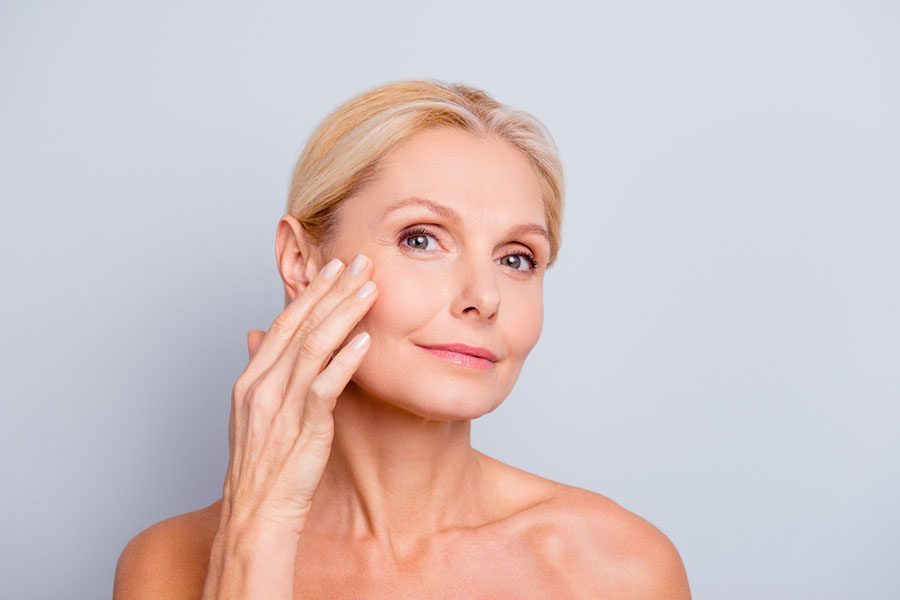What Does a Chemical Peel Do to Your Face?

By Roman Samborskyi / Shutterstock.com
By now, you probably know that a chemical peel exfoliates your face. But you may be wondering how exactly it accomplishes that exfoliation, especially when you aren’t physically scrubbing at the skin? In this guide, we’ll dive into the science of chemical face peels and explain what your options are when it comes to chemical exfoliation.
What Does a Chemical Peel Do to Your Face?
The answer to “what does a chemical peel do to your face?” lies in the science of skin cells. The top layer of your skin is called the epidermis, and it constantly sheds dead skin cells. In fact, you lose about 30,000 to 40,000 dead skin cells off the surface of your skin every minute of every day. This means that your top layer of skin completely replaces itself every two to four weeks. That’s a lot of dead skin cells!
Most of these dead skin cells wash away in the shower, but some of them stay behind, stuck to the rest of your skin with molecular level bonds that act like glue. This can lead to clogged pores, dry patches, flakes, rough texture, and other unpleasant side effects. Getting a chemical peel will help to remove these dead skin cells faster, revealing smooth, glowing skin underneath.
Chemical peels work to get rid of these dead skin cells by temporarily changing the pH of your skin in a way that allows these bonds to dissolve. Your skin normally has a pH of around 5.5, while a chemical peel temporarily lowers it to a pH of around 3.8. This temporary rise in acidity loosens the cells that hold dead skin cells onto the healthy ones, allowing them to be washed away and promoting the growth of new skin cells.
Shop Acid Face Peels from Lancer Skincare

By New Africa / Shutterstock.com
What Chemical Peel Options Do You Have?
There are many different kinds of acids used in chemical peels, as well as various combinations thereof. These fall into two different categories: alpha hydroxy acids (AHAs) and beta hydroxy acids (BHAs). Popular AHAs include glycolic acid, lactic acid, mandelic acid, and more. Popular BHAs include salicylic acid and sometimes citric acid as well. AHAs are used to address a wide range of conditions, including enlarged pores, fine lines, uneven skin tone, mild hyperpigmentation, and more. BHAs are mostly used to address acne as well as sun damage. Sometimes you can find chemical peels that combine AHAs and BHAs together, so you can get the benefits of both types of acids.
Professional acid face peels are available in dermatologist and aesthetician offices and come in three different levels of strengths: light, medium, and deep. Light chemical peels require little to no downtime and only remove cells from the top layer of skin. Medium chemical peels remove skin cells from both the epidermis and the top of the dermis; recovery can take up to a week and may require downtime. Deep chemical peels remove even more layers of skin cells and typically require a pre-treatment routine as well as significant downtime.
You can also get at-home chemical peel products like those offered by Lancer Skincare. These at-home glycolic acid peels are available in milder leave-on formulations as well as stronger wash-off treatments. They can be used between one to three times a week depending on the formulation and your skin’s tolerance for exfoliation.

By fizkes / Shutterstock.com
What Are the Benefits of Chemical Peels?
Chemical peels can be used to address many different skin conditions. At-home or light chemical peels are best for removing dry or flaking patches, smoothing out skin texture, addressing mild acne, and mitigating fine wrinkles. Medium chemical peels can help to treat skin discoloration, age spots, acne scarring, and fine to moderate wrinkles. Deep chemical peels are used for more severe acne scarring, blotchy or sun damaged skin, and moderate wrinkles.
Your dermatologist will be able to tell you whether or not a chemical peel can address your skincare concerns, and, if so, what type of acid and level of peel would be most appropriate for you. But you don’t have to go to an aesthetician office to reap the benefits of a chemical peel — you can start doing them at home with skincare products like those offered by Lancer Skincare.
Developed by celebrity dermatologist Dr. Harold Lancer and based on tried-and-true ingredients, our chemical peels are a great way to incorporate exfoliating into your weekly routine. Like all our products, our chemical peels come with a 100% satisfaction and ship free within the U.S. Try our chemical peels today to see and feel the difference in your skin!
 PREVIOUS (Happy Holidays from Dr. Lancer!)
PREVIOUS (Happy Holidays from Dr. Lancer!) NEXT (How to Do a Glycolic Acid Peel at Home...)
NEXT (How to Do a Glycolic Acid Peel at Home...)